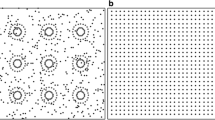Abstract
In complete block experiments, treatments are often randomized within blocks without any other restrictions. When the blocks are rows of plots and the blocks are laid out in parallel so that also columns of plots are formed, there might be random effects of both rows and columns. In this situation, a row–column design is a natural choice. Super-valid restricted randomization is another option. This article compares these randomization procedures for small complete block experiments (5–10 treatments in 3–6 blocks). Validity of a randomization procedure is defined for mixed-effects models. The two randomization procedures are compared with regard to average variance in pairwise comparisons. Row–column randomization is recommended when either there are at least four replicates, or the number of replicates is three and intercolumn variance is not known to be small. These conclusions assume a model with fixed effects of treatments and random effects of rows and columns, and estimation using the REML method and the Kenward and Roger approximation.


Similar content being viewed by others
References
Azaïs, J.M., Bailey, R.A., Monod, H. (1993), “A catalogue of efficient neighbour-designs with border plots,” Biometrics, 49, 1252–1261.
Bailey, R.A. (2012), “Experiments in rectangular areas: design and randomization,” Journal of Agricultural, Biological, and Environmental Statistics, 17, 176–191.
Bailey, R.A., Rowley, C.A. (1987) “Valid randomization,” Proceedings of the Royal Society: Series A, 410, 105–124.
Caliński, T., Kageyama, S. (2000), Block Designs: A Randomization Approach, Volume I: Analysis, New York: Springer.
Fisher, R.A. (1925), Statistical Methods for Research Workers, Edinburgh: Oliver & Boyd.
Grundy, P.M, Healy, M.J.R. (1950), “Restricted randomization and quasi-complete Latin squares,” Journal of the Royal Statistical Society: Series B, 12, 286–291.
John, J. A., Mitchell, T. J. (1977), “Optimal incomplete block designs,” Journal of the Royal Statistical Society: Series B, 39, 39–43.
John, J.A., Williams, E.R. (1995), Cyclic and Computer Generated Designs, 2nd ed, London: Chapman & Hall.
Kackar, R. N., Harville, D. A. (1984), “Approximations for standard errors of estimators of fixed and random effects in mixed linear models,” Journal of the American Statistical Association, 79, 853–862.
Kempthorne, O. (1953), “The efficiency factor of an incomplete block design,” The Annals of Mathematical Statistics, 27, 846–849.
Kenward, M. G., Roger, J. H. (1997), “Small sample inference for fixed effects from restricted maximum likelihood,” Biometrics, 53, 983–997.
Littell, R.C., Milliken, G. A., Stroup, W. W., Wolfinger, R. D., Schabenberger, O. (2006), SAS for Mixed Models, Cary NC: SAS institute.
Mandal, B.N., Parsad, R., Gupta, V.K. (2013), Incomplete block designs for making all possible pairwise treatment comparisons: design resources server. Indian Agricultural Statistics Research Institute(ICAR), New Delhi 110 012, India. www.iasri.res.in/design (accessed lastly on November 4, 2015).
Patterson, H. D., Thompson, R. (1971), “Recovery of inter-block information when block sizes are unequal,” Biometrika, 58, 545–55.
Piepho, H.-P., Williams, E.R., Michel V. (2015), “Nonresolvable row–column designs with an even distribution of treatment replications,” Journal of Agricultural, Biological, and Environmental Statistics. doi:10.1007/s13253-015-0241-2.
Preece, D.A., Bailey, R.A., Patterson, H.D. (1978), “A randomization problem in forming designs with superimposed treatments,” Australian Journal of Statistics 20, 111–125.
Williams, E.R, Piepho, H.P. (2014), “An evaluation of super-valid restricted randomization,” Journal of Agricultural, Biological, and Environmental Statistics, 19, 472–480.
Yates, F. (1939), “The comparative advantages of systematic and randomized arrangements in the design of agricultural and biological experiments,” Biometrika, 30, 440–466.
——– (1964), “Sir Ronald Fisher and the design of experiments,” Biometrics, 20, 307–321.
Acknowledgments
Many thanks are due to Prof. R. A. Bailey and all anonymous reviewers for their respective constructive comments. Many thanks are also due to Dr. J. Hagman for providing the example. The Swedish Board of Agriculture financed the potato experiments.
Author information
Authors and Affiliations
Corresponding author
Appendix
Appendix
Let A and B be any two treatments. According to Azaïs et al. (1993), a randomization procedure is strongly valid (Definition 2) for a complete block experiment with n treatments if the following two conditions are satisfied:
-
If plots s and t are two arbitrarily selected plots in the same block, then the probability is \(1/(n(n-1))\) that treatment A is randomized to plot s and treatment B to plot t.
-
If plots s and t are two arbitrarily selected plots in different blocks, then the probability is \(1/n^2\) that treatment A is randomized to plot s and treatment B to plot t; and the probability is \(1/n^2\) that treatment A is randomized to both plot s and plot t.
In the following, it is shown that super-valid restricted randomization is strongly valid, since the above two conditions are met. Let \(z = C\) denote the event that treatment C is randomized to plot z, and let \(z \ne C\) denote the event that C is not randomized to z. First, let plots s and t be two distinct arbitrarily selected plots in the same block. Then \(\text {Pr}[(s = A)\cap (t = B)] = \text {Pr}[s = A] \, \text {Pr}[(t = B)|(s = A)] = (1/n)(1/(n-1)) = 1/(n(n-1))\). Next, let plots s and t be two arbitrarily selected plots in different blocks. Then \(\text {Pr}[(s = A)\cap (t = B)] = \text {Pr}[(s=A)\cap (t = B)\cap (t \ne A)] = \text {Pr}[s = A] \, \text {Pr}[(t \ne A)|(s = A)] \, \text {Pr}[(t = B)|((s = A)\cap (t \ne A))] = (1/n)(((n - 1))/n)(1/(n-1)) = 1/n^2\), and \(\text {Pr}[(s = A)\cap (t=A)] = \text {Pr}[s = A] \text {Pr}[(t = A)|(s = A)] = (1/n)(1/n) = 1/n^2\).
Rights and permissions
About this article
Cite this article
Forkman, J. A Comparison of Super-Valid Restricted and Row–Column Randomization. JABES 21, 243–260 (2016). https://doi.org/10.1007/s13253-016-0246-5
Received:
Accepted:
Published:
Issue Date:
DOI: https://doi.org/10.1007/s13253-016-0246-5



